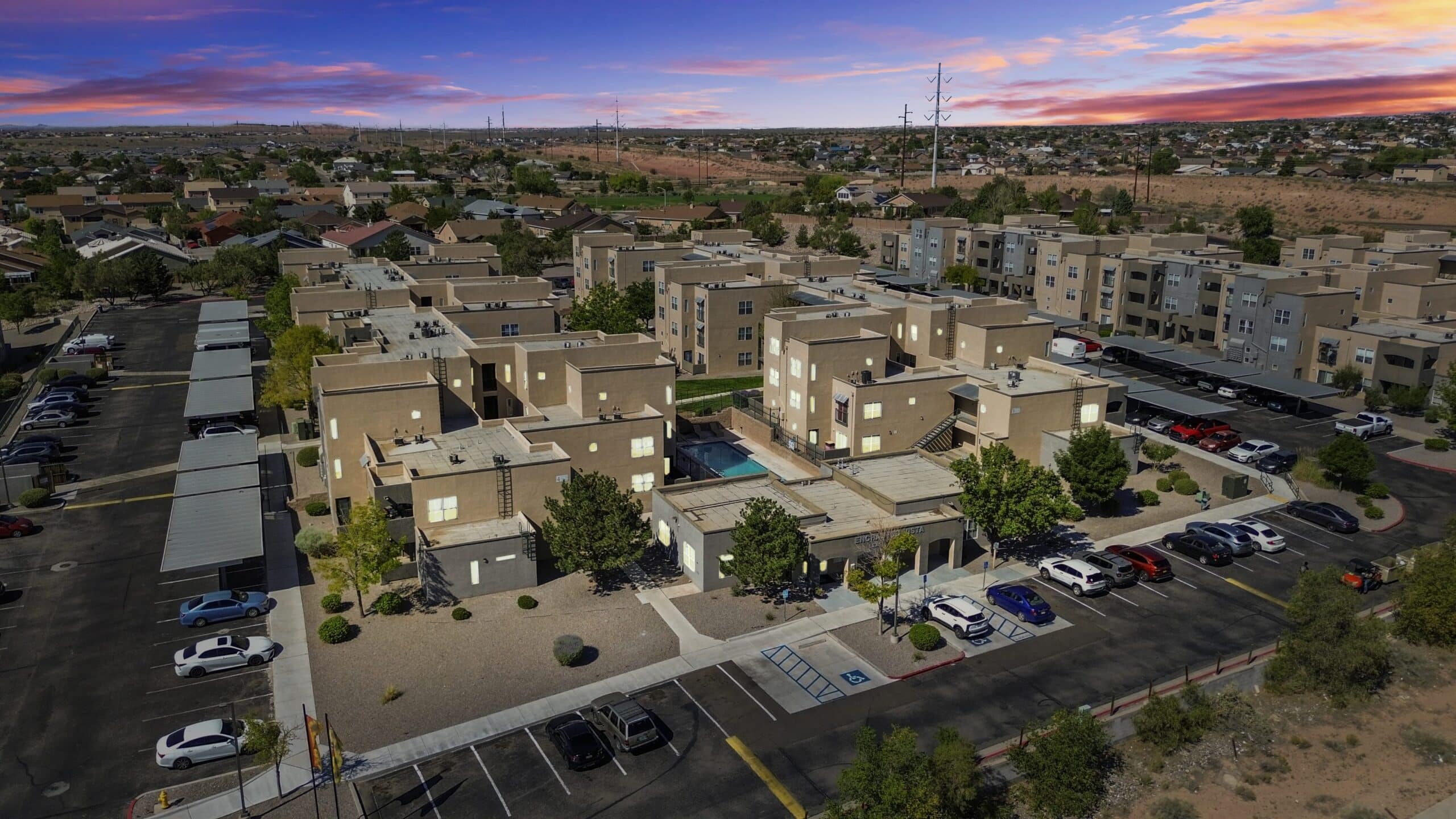A Record Setting Preservation Deal Closes in Oregon and New Mexico

By Abram Mamet
10 min read

A massive multi-asset preservation deal recently closed in the western United States, demonstrating what can happen when scale, efficiency, and earnest mission-driven work combine.
Veteran developer and operator Guardian Real Estate Services has acquired a total of 3,050 units across 15 properties in both Oregon and New Mexico from seller GSL Properties, representing $497 million dollars in assets. In a massive preservation win for the region, all currently restricted units (the vast majority of the portfolio) will retain their affordability, according to Guardian; additionally, the small handful of market-rate units in the mix will eventually transition to restricted affordable.
The deal occurred in two phases: an initial two-project transaction completed with institutional capital partner AEW, and a second 13-project joint venture acquisition with partner National Equity Fund (NEF) and investor JP Morgan. According to national housing bond firm Orrick, who helped advise the second deal, the total portfolio acquisition was split between $102 million for the first phase and $395 million for the latter.
This transaction represents Guardian’s largest portfolio acquisition to date and stands among the most substantial deals in affordable housing history, according to the firm. As fund manager, NEF brought much-needed equity to the transaction through its partnership with JPMorgan. The $444 million total transaction cost supported both the initial acquisition and long-term Capital Expenditures, with NEF’s equity commitment representing the largest single investment in the company’s 38-year history.

Though the deal is large, the affordability restrictions are fairly straightforward, making overall compliance easy and efficient. “The vast majority of the portfolio are 60 percent AMI, straight-up Low-Income Housing Tax Credit (LIHTC) units,” says Tom Brenneke, Guardian’s president and founder. “There’s a chunk of Section 8 vouchers” — about 15 percent, he estimates — “but we don’t have any set-asides to manage, and no Permanent Supportive Housing, no service providers, no social service contracts, or Memoranda of Understanding.”
The Power of Network
According to Brandon McCall, vice president of structured finance for NEF, the sale of the properties mainly came about because the seller was “looking to let go of some assets and do what I call a ‘pivot’ to his younger generation.”
However, the landmark deal took some time to proceed, and eventually coalesced due to relationships and positive reputations within the Pacific Northwest, says Brenneke. He credits a strong brokerage relationship with global real estate services company JLL with catalysing the initial relationship. “JLL was representing the seller, GSL Properties. So right there, we had a mutual relationship.”

Through JLL, Guardian found out about two properties on the market: the 216-unit Briarcreek Apartments and the 91-unit City Center Apartments, both in leafy Hillsboro, a suburb of Portland, Oregon. Both assets were former Low Income Housing Tax Credit (LIHTC) properties nearing the end of their extended use period, and according to Brenneke, GSL had been marketing them towards potential buyers looking to convert them to market-rate once that extended use period expired.
However, GSL was interested in maintaining the affordability for the units, and so JLL alerted the mission-oriented Guardian to the sale. “We were invited to participate. We knew the seller — Portland is a small town, and he’s a Portland-based developer. So we got in the hunt, and ended up landing the first two deals.” That two-project transaction closed in April.
During negotiations for the initial deal, it became clear that the seller was interested in a far larger transaction than Guardian initially realized. “In the middle of the transaction, it was expressed to us that GSL was interested in selling another chunk of their portfolio,” Brenneke recalls. “So before we got the first two closed, we were already going to work on the next chunk of assets.”
For the second, much larger deal, Guardian tapped NEF, who they had worked with previously only on smaller LIHTC transactions. According to McCall, the combination of NEF’s expertise as a national real-estate investment manager and Guardian’s position as a respected affordable developer in the region allowed the team to put together a “competitive” bid. “It was a collaborative effort, thinking about how big we want to go, what deals fit what.”
Some of the properties included in that second deal were, in the Portland metro:
- Wyndhaven Apartments (396 units)
- Woodridge (264 units)
- Westridge Meadows Apartments (272 units)
- Gresham Station (253 units)
And in the Albuquerque metro:
- Silver Moon Lodge (151 units)
- El Paseo Apartments (166 units)
- Manzano Mesa (224 units)
- La Cantera (185 units)
- La Terraza Senior (114 units)
- Paseo Del Sol (124 units)
Despite the breadth of the transaction, McCall says negotiations and the closing took a brisk five months, a speed “we felt was pretty shocking, to acquire that many units that quickly. It definitely was a quick execution, given its size.”
On this specific deal, since it was so large, McCall said he felt it was important that the individual flavor of each project not be lost. “I went out and saw all the sites — that was an interesting experience. Usually we’re doing acquisitions of one or two projects at once, but doing 13 took several days. However, each property and the stories of residents at each was something we never want to miss.” This thorough vetting was worth it, he says. “Feeling it, sensing it, adds a personal element and amplifies the story on a bigger level.”
Brenneke credits the power of network and a shared vision for the community as helping to ease the massive deal. “We’re a larger operator, owner and developer of affordable housing, and have a good reputation in the market,” he says. “We knew the brokers, they know us well. So there was a comfort level.”

Additionally, there was strong motivation to keep these units affordable for the long term, says NEF senior vice president of structured finance Daryl Shore, further expediting the process. “You had a willing investor who really wanted to make sure we preserved those units in JP Morgan,” he says. “And that’s part of our mission at NEF, too — to create more and preserve existing affordable housing. We were motivated as an organization to make sure that we could move this through our process diligently and work intentionally with our investor and sponsor to get it closed.”
Guardian credits the closing of this deal to their team’s steadfast commitment to preserving affordability. “You’ve got a lot of groups that get stars in their eyes when they look at extended use agreements expiring in a few years,” Brenneke says. In the Pacific Northwest, this can mean charging as much as $400 a month more in rent once restrictions expire. “Brokers will go out and try to pitch these homes as future market-rate units. Buyers think, ‘gosh! We can convert these to market and make a whole bunch of money.’”
But “that’s a hard path,” Brenneke warns. “You have to touch real lives of people who are no longer able to afford housing.”
Preserving — and Expanding — Affordability
According to both NEF and Guardian, nearly all of the units are coming up on the end of their LIHTC compliance periods. However, as part of their underwriting and investment terms, NEF has required that Guardian maintain the affordability restrictions in place at the time of transaction.
Not only will Guardian maintain that affordability, but according to Brenneke, they will also use this opportunity to expand affordability for local residents.
At the time of transaction, about seven percent of the portfolio’s units had unrestricted market-rate rents. Rather than utilizing those rents as a cash cow and charging whatever maximum the markets will bear, Brenneke says that “our business plan has those converting to affordable at 60 percent Area Median Income (AMI).”
Guardian will accomplish this by leveraging local tax abatements, allowing them to recoup any potential losses taken by offering the units at a restricted rate. To access the tax abatements, Guardian introduced a nonprofit to their ownership entity. “It just made the best economic sense for us. And it’s cleaner to simply take those other units and take the tax abatement and convert those to affordable.”
Importantly, rather than converting the units now, these will transition over a gradual period so as not to displace current residents who may be earning above a 60 percent AMI. “We don’t evict people. For that reason, our market-rate units will convert to affordable at turnover. They have no tax abatements on those units now, but as they convert, we’ll roll them up annually and go back to the county, show them how many converted, and then we’ll get our tax abatement.”

This process speaks to what Shore says is critical in partnerships that NEF pursues: a commitment to long-term affordability, even after NEF exits a deal. “Across our portfolio, we always look for opportunities to preserve affordability,” he says. “If there’s a tax abatement in place that will extend beyond our financing period, we know that through the terms of our financing — through the underwriting, through the structuring, through the partnership with the sponsor — affordability will be maintained, even when we are taken out through recapitalization or otherwise exit our investment. We always look for those opportunities.”
Interestingly, affordability will be maintained without utilizing any extra subsidy beyond the tax abatements. “It’s a fairly straightforward, clean deal,” Brenneke says. “Any soft debt was paid off. There’s only the property tax abatement.”
To make this clean funding stream possible, Brenneke says that the partnership leveraged what he calls the “secret sauce” of the deal: Fannie Mae’s Credit Facility program. A loan structure that allows an owner to manage debt across an entire portfolio, the credit facility “lends itself to a lot of efficiencies in such a large transaction,” he says. “It was the first time we’d ever done this facility. $272 million, .86 over the seven year treasury — the rates were fabulous. And the terms were fabulous. It was interest-only.”
Orrick served as a legal advisor on the credit facility, which JLL arranged. Despite its size, Brenneke marvels at how smooth and effective Fannie Mae was during the process. “The irony here is that they were actually ahead of us on the transaction timeline,” he says. “Fannie, to their credit, just glided right through it.”
Both teams say they look forward to pursuing this type of large multi-asset preservation strategy again. “The preservation of these units continues to help move the needle to address the affordable housing crisis,” says Shore. “There’s no one-size-fits-all solution to addressing such a massive crisis. That’s why NEF has evolved as an organization that can plug in at different parts, engaging across every aspect of the multifamily affordable housing ecosystem. We’re proud to be a part of this transaction, because it amplifies the need to not only just build units, but preserve them.”
